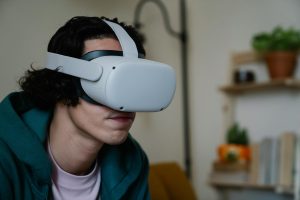AR and VR Products Leading the Market in 2024
AR and VR Technologies
Augmented Reality (AR) and Virtual Reality (VR) have transitioned from being futuristic concepts to integral parts of various industries today. These technologies have revolutionized sectors such as gaming, healthcare, education, and real estate, enhancing user experiences and providing new ways to interact with the digital and physical world. As we move into 2024, the AR and VR market continues to expand, with new products and innovations driving growth and adoption.

Understanding AR and VR: Definitions and Differences
What is Augmented Reality (AR)?
Augmented Reality overlays digital content onto the real world, enhancing what we see, hear, and feel. Unlike VR, AR doesn’t create a fully immersive environment; instead, it supplements reality with digital information. Examples of AR include mobile apps like Pokémon GO and Snapchat filters, as well as more sophisticated applications in fields like navigation and maintenance.
What is Virtual Reality (VR)?
Virtual Reality, on the other hand, immerses users in a completely digital environment, shutting out the real world. VR requires specialized headsets, like the Oculus Rift or PlayStation VR, to transport users into a different reality altogether. VR is widely used in gaming but has also found applications in training simulations, virtual tours, and remote collaboration.
Market Growth and Trends
The Expanding Market for AR and VR Products
The AR and VR market has seen rapid growth in recent years, and this trend is expected to continue through 2024 and beyond. According to market research, the global AR and VR market size is projected to grow from $37 billion in 2023 to over $114 billion by 2027, reflecting a compound annual growth rate (CAGR) of approximately 27%.
Key Drivers of AR and VR Growth
Several factors are driving the expansion of the AR and VR market:
- Technological Advancements: Continued improvements in hardware and software have made AR and VR products more accessible and user-friendly. Innovations such as lighter, more comfortable headsets, higher resolution displays, and more responsive tracking systems are enhancing user experiences.
- Increased Adoption Across Industries: AR and VR technologies are no longer confined to gaming. Industries such as healthcare, education, real estate, and manufacturing are integrating these technologies into their operations, driving demand for AR and VR products.
- Rising Consumer Interest: As AR and VR products become more affordable and widely available, consumer interest continues to grow. This is particularly true in the gaming and entertainment sectors, where immersive experiences are highly valued.
Top AR and VR Products for 2024
- Meta Quest 3
The Meta Quest 3 is the latest iteration of the highly successful Oculus Quest series. This standalone VR headset offers a perfect balance of performance, affordability, and portability. It features improved graphics, a more comfortable design, and enhanced tracking capabilities, making it a top choice for both new and experienced VR users.
- Apple Vision Pro
Apple’s entry into the AR/VR space, the Vision Pro, is a game-changer. This mixed reality headset combines AR and VR capabilities, offering users a seamless experience. With its advanced optics, powerful processing, and integration with the Apple ecosystem, the Vision Pro is set to become a leading product in the market.
- PlayStation VR2
For console gamers, the PlayStation VR2 is the ultimate VR experience. Built for the PlayStation 5, this headset boasts high-fidelity visuals, adaptive triggers, and haptic feedback, providing an immersive gaming experience like no other. Its ease of use and integration with PlayStation’s gaming ecosystem make it a top pick for 2024.
- Microsoft HoloLens 3
The HoloLens 3 is Microsoft’s latest AR headset, designed for enterprise use. It offers superior spatial mapping, gesture recognition, and holographic projection capabilities, making it ideal for industries like manufacturing, healthcare, and design. Its robust build and enterprise-focused features set it apart in the AR market.
- HTC Vive XR Elite
The HTC Vive XR Elite is a high-end VR headset aimed at professional users and enthusiasts. It offers ultra-low latency, high-resolution displays, and a wide field of view, providing a truly immersive experience. With support for both VR and AR applications, the Vive XR Elite is a versatile and powerful tool for a wide range of users.
Comparative Analysis of AR and VR Products
Product Comparison Table
| Product | Type | Target Audience | Key Features | Price Range |
| Meta Quest 3 | VR | General Consumers | Standalone, improved graphics, portability | $300 – $500 |
| Apple Vision Pro | Mixed Reality (AR/VR) | Tech Enthusiasts/Professionals | Advanced optics, seamless Apple integration | $2,999 – $3,499 |
| PlayStation VR2 | VR | Console Gamers | High-fidelity visuals, adaptive triggers | $499 – $599 |
| Microsoft HoloLens 3 | AR | Enterprises | Superior spatial mapping, robust build | $3,500 – $5,000 |
| HTC Vive XR Elite | VR/AR | Professionals/Enthusiasts | Ultra-low latency, high-resolution displays | $999 – $1,299 |
Key Insights
- Affordability vs. Features: The Meta Quest 3 offers a balanced mix of features and affordability, making it an excellent choice for general consumers. In contrast, products like the Apple Vision Pro and Microsoft HoloLens 3 are premium devices aimed at professionals and enterprises, offering advanced features at a higher price point.
- Target Audience: The PlayStation VR2 is specifically designed for console gamers, with features tailored to enhance gaming experiences. On the other hand, the HTC Vive XR Elite and Microsoft HoloLens 3 cater to professionals, offering advanced capabilities for industry-specific applications.
- Technology Integration: Apple’s Vision Pro stands out for its seamless integration with the broader Apple ecosystem, making it an attractive option for users already invested in Apple products.
Industry Impact and Future Outlook
AR and VR in Various Industries
The adoption of AR and VR technologies is transforming industries:
- Healthcare: VR is being used for surgical simulations, medical training, and patient therapy, while AR assists in complex surgeries and diagnostics.
- Education: AR and VR are enhancing learning experiences by providing immersive and interactive environments, particularly in remote education.
- Real Estate: VR allows potential buyers to take virtual tours of properties, while AR aids architects and designers in visualizing projects in real-time.
- Manufacturing: AR is used for equipment maintenance, assembly line assistance, and training, improving efficiency and reducing errors.
Challenges and Opportunities
While the AR and VR market is growing rapidly, challenges remain:
- Hardware Costs: High-quality AR and VR devices remain expensive, limiting widespread adoption.
- Content Availability: The success of AR and VR depends heavily on the availability of compelling content. As more developers create applications and experiences for these platforms, consumer interest will continue to grow.
- Technical Limitations: Issues like motion sickness, limited battery life, and the need for powerful computing hardware still pose challenges. However, ongoing research and development are addressing these limitations, promising better experiences in the near future.
Future Trends
Looking ahead, several trends are likely to shape the AR and VR market:
- Advancements in AI: Integration of AI with AR and VR will enhance user experiences, making interactions more natural and intuitive.
- Expansion of 5G Networks: The rollout of 5G will significantly improve the performance of AR and VR applications, particularly in mobile settings.
- Broader Industry Adoption: As AR and VR technologies become more affordable and accessible, more industries will integrate them into their operations, driving further market growth.
Conclusion
The AR and VR market is poised for significant growth in 2024, driven by technological advancements, increased industry adoption, and rising consumer interest. With a wide range of products catering to different needs and budgets, AR and VR technologies are becoming increasingly integral to both personal and professional life. As these technologies continue to evolve, they will undoubtedly unlock new possibilities and redefine how we interact with the world around us.




